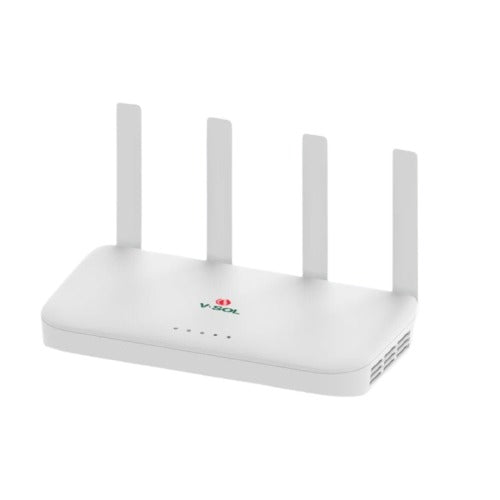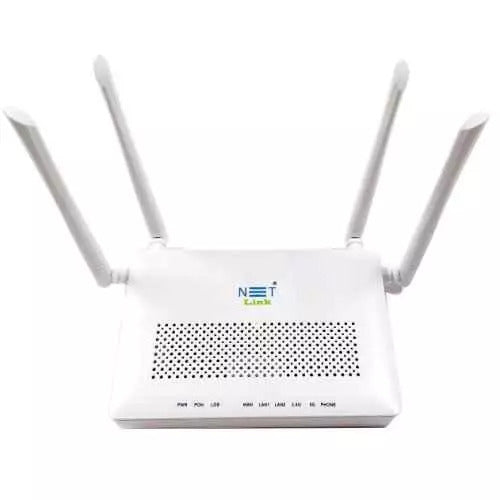
Wi-Fi 6 ONT Routers - Video streaming without buffering
Buffering. The word evokes impatience and frustration. Streaming video on Wi-Fi 6 ONT routers is no longer a problem. Slow internet speeds and inconsistent connections can disrupt our streaming experience, causing interruptions and delays.
Technology has evolved since the start of Wi-Fi. Our modern wireless connections support Wi-Fi 6 (802.11ax), the latest wireless standard. The routers transform video streaming by addressing common issues, such as buffering and unstable connections.
|
Feature |
Value |
|
Speed |
5400Mbps |
|
Range |
2500 sq. ft. |
|
Capacity |
Supports up to 6 simultaneous streams |
|
Latency |
20ms |
|
Network congestion |
Reduced congestion for smoother streaming |
|
Playback |
Uninterrupted and smooth playback |
|
Streaming experience |
Optimized for 4K streaming and VR gaming |
|
Speciality |
Enhanced performance for video streaming and gaming |
Wireless 6 routers operate in two frequencies: 5GHz and 2.4GHz. Various forms of bonds have their advantages and apply to different purposes. Video streaming is ideal for the 5GHz band because it has higher speeds and is less prone to interference. Further, the 2.4GHz band provides better penetration through walls, making it suitable for devices located farther away. This dual-band capability allows Wi-Fi 6 routers to handle more devices and perform better than Wi-Fi 5, even in crowded environments.
The 5GHz band is where Wi-Fi 6 routers shine when it comes to video streaming. The Wi-Fi 6 routers have improved modulation schemes and wider channels and can send over 120% faster than the previous generation, 802.11ac routers at 5GHz. Streaming HD content is smooth as buffering is minimal, compared to older Wi-Fi routers.
5GHz potential of Wi-Fi 6 ONT routers
The 4800 Mbps speed is a game-changer for anyone demanding high-bandwidth activities. A 1.5GHz tri-core CPU and 512MB of RAM power Broadcom's BCM6750 system-on-a-chip. Watching movies, playing games, or working with large files will be seamless and uninterrupted with this level of speed. Video streams in 4K need considerable current bandwidth, especially high-definition videos. Your favorite movies and TV shows will not buffer or degrade in quality when you have a Wi-Fi 6 router operating at 4800 Mbps on the 5 GHz band. Smooth playback lets you appreciate the action on screen with no interruptions.
Lag can hurt your gaming experience, and every millisecond counts. With a Wi-Fi 6 router, you can experience minimal latency and ultra-responsive gaming. Moreover, the 4800 Mbps speed on the 5 GHz band enables faster downloads and uploads. When compared to older Wi-Fi standards, this speed allows you to work with large files or transfer data. Uploading files to cloud storage, sharing videos with friends, or collaborating on projects becomes a breeze with such high speeds.

It's worth noting that the 4800 Mbps speed is achievable in ideal conditions. Factors such as distance from the router, obstructions, and interference from other electronic devices can impact the actual speed experienced. Older devices connect if your router doesn't support Wi-Fi 6, but their speeds may be slower. Because Wi-Fi 6 routers are backward compatible, they can connect to older Wi-Fi devices, though at slower speeds. Connected devices, area size, and interference are all factors to consider. Medium to large homes can connect up to 25 devices to the router.
Say goodbye to buffering and improve streaming quality
How does all this affect your streaming experience? In simple terms, Wi-Fi 6 routers end buffering and provide a smoother playback experience. With their improved speeds, reduced latency, and reduced network congestion, you can say goodbye to those frustrating pauses and interruptions in your favorite shows and movies. Whether you're enjoying a high-action sequence or a suspenseful thriller, Wi-Fi 6 routers ensure that you don't miss a single moment.
Understanding the key features of Wi-Fi 6 routers will help you understand their benefits. The Institute of Electrical and Electronics Engineers (IEEE) developed Wi-Fi 6 to address previous standards' challenges. Wi-Fi 6 introduces several advancements, including OFDMA enables the simultaneous transmission of data to many devices by dividing a Wi-Fi channel into smaller sub-channels, known as resource units. This division allows for more efficient data transfer, as each sub-channel belongs to a different device or group of devices. By enabling many devices to communicate, OFDMA reduces latency and improves network capacity.

MU-MIMO allows a Wi-Fi router to communicate with many devices at once using many antennas. With MU-MIMO, the router can send and receive data to and from more devices at the same time. This technology improves network efficiency, eliminating the need for devices to compete for airtime, reducing congestion, and enhancing performance. Moreover, these standards come with 1024 QAM technology, which can increase the throughput of devices by up to 25%. Furthermore, the standards feature a 160 MHz contiguous channel width, allowing for greater data transfer and media streaming.
Target Wake Time is a feature of Wi-Fi6 that enhances power efficiency in devices connected to the network. It allows devices to schedule specific time slots for communication with the router, enabling them to conserve energy and extend battery life. With TWT, devices can negotiate with the router to determine when and how often they should wake up to send or receive data. This negotiation ensures that devices wake up only when necessary, minimizing idle time and optimizing power consumption. By synchronizing the wake-up schedules of devices, TWT reduces network latency and improves the efficiency of the Wi-Fi network at large.
WPA3 security for Wi-Fi 6 ONT routers
WPA3 protocol is another noteworthy aspect of Wi-Fi6 routers that enhances security. WPA3 is the latest encryption protocol designed to address vulnerabilities found in previous Wi-Fi security standards. It provides stronger protection against unauthorized access, ensuring networks and data remain secure. WPA3 introduces new features such as Simultaneous Authentication of Equals (SAE) and a 192-bit security suite. SAE improves the security of password-based authentication, making it more resistant to offline dictionary attacks. The 192-bit security suite offers stronger encryption, making it harder for attackers to decrypt transmitted data. By adopting WPA3, Wi-Fi6 routers provide users with enhanced peace of mind and protection against potential security threats. No matter what kind of data you send or browse on the web, the WPA3 protocol ensures your information remains safe.
Conclusion
To appreciate the power of Wi-Fi6 routers in enhancing video streaming, it's worth conducting a speed test. By comparing the performance of a Wi-Fi6 router to previous-generation routers, you can witness firsthand the difference in speeds and streaming experience. Speed tests provide tangible evidence of the capabilities of Wi-Fi6 and its ability to say goodbye to buffering once and for all.



















